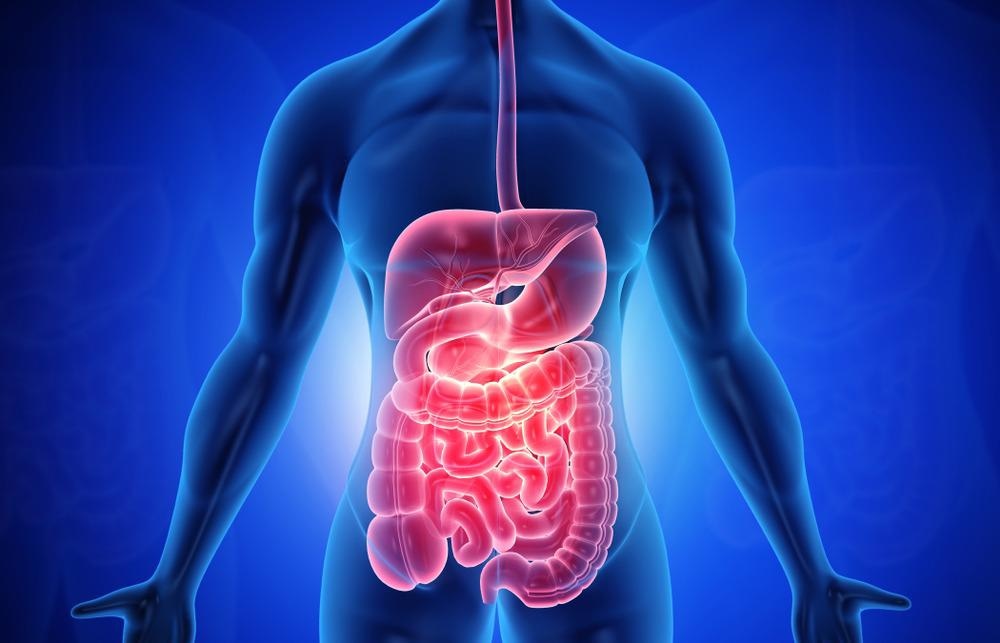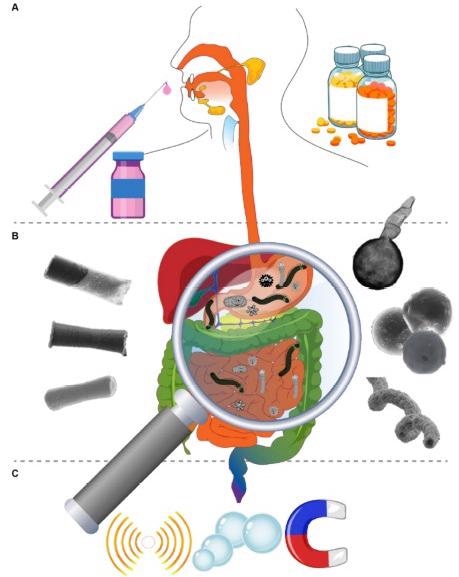Revolutionary research on the use of nano/microbots for use within drug delivery could potentially be used for gastrointestinal diseases. A review published in the journal, Energies, has evaluated the traction of this research for its innovative biomedical application.

Study: Nano/Microrobots Line Up for Gastrointestinal Tract Diseases: Targeted Delivery, Therapy, and Prevention. Image Credit: Explode/Shutterstock.com
Tiny Robots for Disease Treatment
The idea of smart tiny robots which can repair damage in the body has always been thought of as a fictional concept; however, innovative researchers have been able to translate this idea for biomedical applications.

Schematic of reported in vivo treatment and imaging of stomach diseases using nano/microrobots. (A) Invented oral medicine based on nano/microrobots for prevention (vaccine) and treatment (tablet) of stomach diseases, (B) presenting the morphology of the reported nano/microrobots employed for treatment of stomach diseases and imaging. (C) Presenting the means used to propel nano/microrobots in the treatment of stomach diseases. © Děkanovský, L., Li, J., Zhou, H., Sofer, Z. and Khezri, B., (2022)
Nano/microrobots (NMRs) are miniature devices that can convert energy into motion, with the ability to operate at micro and nanoscale sizes. This incorporation of nanotechnology for advanced biomedical applications such as gastrointestinal tract disease treatment could revolutionize the field of medicine with a more personalized and targeted approach to therapeutics.
NMRs built from optimized and functionalized materials can swim within the body using either a chemical fuel from its environment or an external source, including magnetic fields, acoustic waves, and even light.
The first report on NMRs included rod-shaped gold/platinum nanomotors, which was driven by hydrogen peroxide catalytic reactions. Since this research, the field of NMRs has progressed into more complex and intricate designs utilizing materials such as polymers, 2D and hybrid materials, and metal organic frameworks for sophisticated applications.
Benefits of NMRs
The benefits of NMRs for drug delivery include their tiny size and motility, which allows them to interact with biological systems organically. This method of localized drug delivery increases the efficiency of treatment with targeted dosages and reduction of adverse side effects to healthy tissue.
Targeted drug delivery faces challenges within clinical practice, such as finding the target in a specific disease, a drug that can cure or prevent the disease as well as utilizing a drug carrier that is able to reach the target safely.
This innovative approach to enhance drug delivery may be able to solve these challenges with NMRs having the ability to function as an active self-propelled platform that can protect the drug cargo it is carrying and have high selectivity enabling it to penetrate targeted tissue at the correct time and location.
A few prerequisites that NMRs require to achieve innovative enhanced drug delivery systems include high power to drive and fuel the NMRs, control motion and the ability to navigate through predefined pathways, and electrostatic and hydrogen bonding between the robots and drugs.
These potentially revolutionary robots have been successfully utilized for other applications outside of drug delivery, with applications such as sampling, biopsy, imaging, tissue engineering, and gene and cell delivery.
However, these studies illustrate success with proof-of-concept and with further research, NMRs may be able to be used within clinical practice and travel within the body with the potential to replace conventional treatments that are challenged with accessing certain organs.
Gastrointestinal Tract Disease Applications
With Helicobacter pylori (H. pylori) being one of the most common bacterial infections and most responsible for disorders, including inflammatory gastritis, stomach ulcers, and even risk for gastric cancer, targeting stomach and intestinal diseases is critical.
The conventional treatment of H. pylori may consist of a three-course treatment of two different antibiotics and a proton pump inhibitor. However, previous studies suggest prolonged treatment with multiple broad-spectrum antibiotics and proton pump inhibitors resulting in health complications such as C. difficile infection, dementia, pneumonia, antiplatelet agents, kidney disease and others, alternative approaches with higher targeting ability are required.
NMRs for use within stomach diseases have been researched, with studies including zinc-based microrobots utilized in a live mouse model.
The microrobots were produced using the electrochemical deposition method and resulted in NMRs that could swim autonomously in simulated gastric fluid, consisting of a pH of 1.2. These NMRs were found to have made their way to the stomach wall within two hours and then the intestines, where they could release gold nanoparticles as they become degraded.
This method of drug delivery may spearhead further research into significant therapeutics such as for gastrointestinal diseases, including IBD, for which there is no cure and requires high maintenance.
Implications for Future Translation
Stomach related diseases can hold significant discomfort for patients and lead to insufficient quality of life; however, with this approach, NMRs can be used to target and deliver drugs without many adverse effects, and with their biodegradability, they can complete their task of delivering drugs without leaving toxic products before dissolving into gastric acid.
However, while this nanotechnology would be revolutionary, there are still obstacles that require overcoming, including being easily modifiable to carry different types of drugs or multiple drugs and being equipped with sensors for diagnostic purposes.
These functionalities would enhance NMRs for various applications from diagnostic and imaging diseases that would otherwise be difficult to treat to increase personalized medicine and quality care of patients.
Continue reading: The Future of Nano-Robots in Industrial Clean-Up Applications and Drug Delivery.
Reference
Děkanovský, L., Li, J., Zhou, H., Sofer, Z. and Khezri, B., (2022) Nano/Microrobots Line Up for Gastrointestinal Tract Diseases: Targeted Delivery, Therapy, and Prevention. Energies, 15(2), p.426. Available at: https://doi.org/10.3390/en15020426
Further Reading
Li, J., Esteban-Fernández de Ávila, B., Gao, W., Zhang, L. and Wang, J., (2017) Micro/nanorobots for biomedicine: Delivery, surgery, sensing, and detoxification. Science Robotics, 2(4). Available at: https://doi.org/10.1126/scirobotics.aam6431
Disclaimer: The views expressed here are those of the author expressed in their private capacity and do not necessarily represent the views of AZoM.com Limited T/A AZoNetwork the owner and operator of this website. This disclaimer forms part of the Terms and conditions of use of this website.